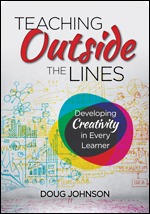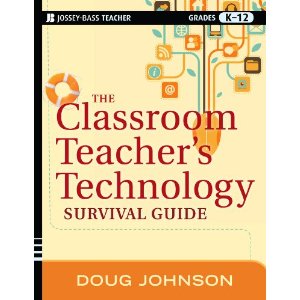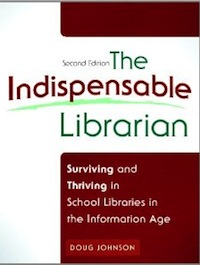
Larry Cuban’s What Happens When a School’s Internet Fails blog post stirred up old nightmares for this long time tech director. In it, Cuban includes an excerpt from an Australian’s book about education and technology that describes a two day outage in a high school.
People racing out of the staff-room are clearly treating this as a big deal. Some teachers remain inside the staff room, moaning that they don’t know what to do because their lessons have been planned around particular apps and online exercises. A couple of the male teachers drop their footy conversations and make a beeline for where the ‘IT boys’ are based in an attempt to find out from the school’s technicians exactly how serious this network glitch is.
A couple years before retirement, my school district experienced a similar multi-day outage. An upgraded piece of network equipment brought down not just the high school’s Internet, but access in every building. For the technology department (and especially for the technology director), it was a rather unpleasant time. Not only did my boss seem to call to “check up on how things were going” on pretty much an hourly basis, I got calls from school board members who had heard from parents and teachers. To be fair, it was probably even more stressful for the poor network manager whose desk was only a few feet from my office. It may have been this outage that started to give the idea of my retirement a warm and inviting glow. Not just to me, but perhaps to all those with whom I worked.
I started my career as a classroom teacher and building librarian in 1976. But in 1991, I accepted a district level position as “Audio Visual Coordinator.” At the time, the department had been primarily about repairing filmstrip and movie projectors, developing b&w film, and circulating 16mm movies. When I was hired, the department expanded to include coordinating the library program and supervising the single half-time math teacher who was in charge of computer repair.
School technology in the early 90s was a different beast. Standalone computers on secretaries’ desks. Computer labs with LANs (Corvus, anyone?). No Internet. No classroom computers. No wifi. No smartphones. Televisions and VCRs on carts that could be rolled from classroom to classroom.
But the 90s were exciting years in educational technology. I got guest accounts from the local university to a VAX email system in 1991. We started putting computers on “early adaptor” teachers’ desks after they completed 40 hours of training that addressed CODE77 Rubrics. We soon gave employees their own email addresses, put up a district website, and networked both buildings and rooms throughout the district. By 1995, I was able to describe in a paper:
… As of September 1994, our district has had direct Internet access in every school site for its 800 staff members and 7500 students. This includes direct simultaneous SLIP connections to the Internet for all networked computers in classrooms, libraries, and offices. These connections allow students and staff to use Fetch, Eudora, Telnet, TurboGopher, Mosaic, and Blue Skies. All personnel currently have e-mail accounts, and students are being assigned e-mail accounts as the curricular needs for them arise. “Mankato Schools Internet Project,” Internet Research, WInter 1995.
Educational technology was a happy option for the teachers and administrators who enjoyed using it and who felt empowered by it. But there were very few, if any, required uses for many years. Each school had its “laggards” who resisted all technology use. We continued to print the daily bulletin out for one high school teacher when all the rest of the staff was happy to receive it via email. (After making him walk to the office to pick it up, he finally started to read the bulletin online.)

Later, student information systems became more sophisticated and accessible to not just administrators but to teachers and parents. Learning management systems allowed teachers to share classroom resources with students, other staff members, and parents. Attendance, lunch counts, gradebooks, report cards, discipline reports, and home/school communication all went digital. (See A (not so) brief timeline of technology efforts in ISD77 1991-2014 for details.)
My long-hoped for dream of getting everyone on board with technology finally was realized. But as the pundit once said, “Be careful of what you ask for - you just might get it.”
During the final ten years of so of my career, technology planning took a turn from the innovative, pioneering work of the first 20 years to primarily addressing three major concerns:
- Adequacy
- Reliability
- Security
Networks and the devices on them needed to be constantly upgraded as more users were added (including students) and data became more visual and auditory. No areas of the buildings could be without wifi access. (One teacher complained because he could not get wifi in the faculty bathroom.) If any system went down for even minutes, the phones rang - a lot. And over the last couple years, concerns about hacking and ransomware and staff/student data privacy and protection were nearly overwhelming.
Everyone was not just using technology (which I had hoped for) but relied on it heavily (which I had not anticipated). The growing need for adequacy, reliability and security meant a growing need for creative budgeting and staffing. Outsourcing services and maintenance were always options to be considered, often to the dismay of district employees.
So as full retirement age approached, I seriously considered if I was still the right person to lead the technology department. Should and could not a younger, better trained person be in charge? And the stress of the critical nature of the job started to eat into my life-long enjoyment of working. It was time to pull the plug.
I suspect most people see changes in their careers as the decades roll by. I will be eternally grateful for the opportunities I had in my accidental work life. May you all be so fortunate as to have a work-life that gives your personal-life meaning and happiness.
 Wednesday, August 17, 2022 at 01:52PM
Wednesday, August 17, 2022 at 01:52PM 






